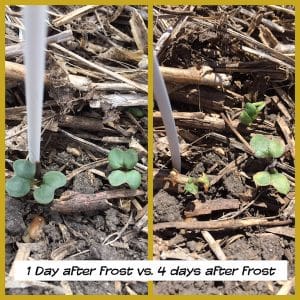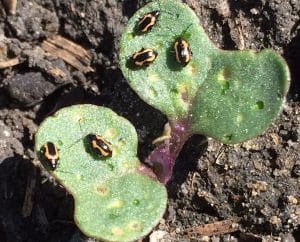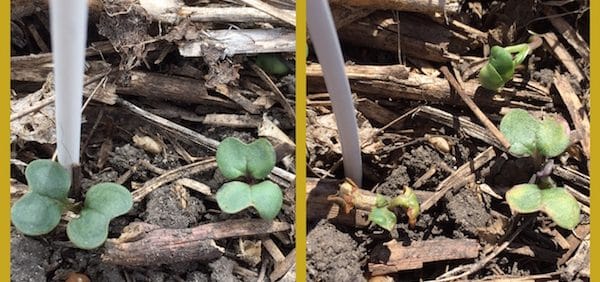About a week after seeding, growers and agronomists can start to evaluate canola stands to make sure they’re emerging as expected. Look throughout the field for issues that could be related to drill performance, frost, excess moisture, insects or disease.
A good first step is to review seeding rates and then run through the plant survival section at canolacalculator.ca. How to use a hoop to do plant counts. NOTE: When doing plant counts, be sure to subtract volunteers. Plants growing outside the seed row are likely volunteers. Very early looking plants are also likely volunteers. You can check by looking for the blue seed coat around the seed.

Frost. Some areas had a heavy frost late last week. Parts of Western Manitoba and Eastern Saskatchewan hit -6°C for a number of hours. Any amount of frost can start taking out plants. One factor is the daily highs leading up to the frost. If days had been cool (10°C), canola plants may be more acclimatized to a heavier frost. If days had been warm (20°C), even a light frost can cause some seedling death. Map of temperatures for the past seven days.. Some fields have been reseeded due to frost, but in many fields, the number of plants that survived the frost did not justify reseeding. READ MORE
Seeder performance. Full rows with poor emergence amid rows with good emergence would suggest a drill problem — maybe due to opener depth or plugged lines. NOTE: A drill could be level in the yard, but how does it perform at working speed? Soil thrown over the front row of openers will make seeds in that row deeper than seeds from back-row openers. To improve performance, the operator could seed slower or consider reducing the depth setting for front openers. READ MORE
Residue. Thick or uneven residue can have implications for frost damage and reduced seeder performance. With regard to frost, residue means the soil doesn’t warm as much during the day and doesn’t release its stored heat as quickly during the night. Seedlings growing up through heavy residue can therefore be more susceptible to frost. Another factor is that seedlings growing up through residue tend to have longer hypocotyls. Because they’re longer, limited energy in the seed often means they’re also thinner and perhaps more susceptible to frost.

Flea beetles. Canola is at greatest risk up to the 4-leaf stage. (Although flea beetles do feed beyond this stage, canola plants usually have enough biomass to grow through the damage with minimal effect.) If flea beetles are overwhelming the seed treatment, consider a spray if more than 25% of leaf area has been eaten and flea beetles are still actively feeding on the crop. With good growing conditions – warmth and moisture – canola can tolerate 50% damage (including to cotyledons), but under high pressure, feeding can progress from 25 to 50% damage and beyond very quickly. Examine newer leaves for recent damage and look for stem feeding. Note that canola seed treatments require a bit of feeding to stop flea beetles, so older leaves may show some damage for this reason while newer leaves may be undamaged indicating the crop is growing ahead of the feeding and a foliar insecticide application is not likely needed. READ MORE
Cutworms. Look for bare patches and dig around the perimeter of the patch to look for cutworms just below the soil surface. Analyze their size – are they big or small? Mature larvae (roughly 3-5 cm) feed less as they prepare to pupate. Young larvae are active-feeders and are more likely to damage crops. Get a second opinion if you’re not sure of the cause or if damage is enough to warrant a spray. The nominal threshold for cutworms has been 25-30% plant loss, but the new cutworm guide has thresholds specific to crops and to cutworm species. For example, the threshold for pale western cutworm in canola is 4-5 larvae per square metre. Are we seeing more cutworms? Some areas seem to have more cutworms than usual. Weather can contribute to outbreaks. In southern Alberta, for example, the winters of 2014-15 and 2015-16 were unusually mild and mild winters mean greater overwintering survival. Conversely, wet springs can increase cutworm mortality due to pathogens. The new cutworm book discusses this at some length. For example, on page 7, it reads:
“Almost all of the cutworm species that affect crops on the Canadian prairies are native to North America and were present prior to European settlement (Beirne 1971). The shift from native grassland complexes to simpler agriculture ecosystems dominated by relatively few crops and tilled soils increased the potential for these species to reach high, economically damaging densities. The likelihood of any one or a number of species achieving this potential in a given year and location is influenced by a combination of factors. The most important is weather, which affects the initial build-up of populations. However, not all cutworm species respond in the same way to environmental triggers. For example, successive dry years increase the potential for pale western cutworm outbreaks; successive wet years favour black cutworm (Walkden 1950).”
Seedling diseases. Seedling diseases caused by fusarium and pythium species tend to be worse in cool, wet conditions while rhizoctonia tends to be worse when canola emergence is delayed due to cool, dry conditions. The broad spectrum fungicide seed treatments used to treat certified seed typically provide good protection from these seedling diseases. The tell-tale sign of disease is patchy emergence up to the four-leaf stage of the crop. Seeds or seedlings may decay prior to emergence or the seedlings may emerge and appear normal, then stagnate at the two- to four-leaf stages. These plants will often die. READ MORE
Early blackleg. Blackleg also effects young canola plants when temperatures have been warm and the soil is moist. The earlier the infection, the higher the yield loss from blackleg. Scout cotyledons looking for greyish-white lesions speckled with black pycnidia. Severe infections will cause girdling of the stem and premature death of the plant. Learn how to identify between seedling diseases and blackleg as for there any some different approaches to manage blackleg in the future years. READ MORE
Further reading:

